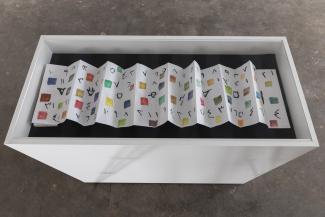What Remains is What the Poets Found
Exhibiting Artists: Basel Abbas and Ruanne Abou-Rahme, Etel Adnan,Saâdane Afif, Özlem Altin, Mariana Castillo Deball, Elif Erkan, Rana Hamadeh, Nona Inescu, Nadia Kaabi-Linke, Tarik Kiswanson, and Joseph Kosuth
Organized and co-curated by Jesi Khadivi and Justin Polera, assisted by Tristan Deschamps
Project coordinator: Henriette Zimmermann
PS120 assistants: Halil Gagam, Alexander Swanson and Caterina Nicolini
With the generous support of Till-Oliver Kalähne and Peter Obstfelder.
February 9th–March 15th
Opening: February 8th, Friday, 18:00-23:00
I came to explore the wreck.
The words are purposes.
The words are maps.
I came to see the damage that was done
and the treasures that prevail. […]
We are, I am, you are
By cowardice or courage
the one who find our way
back to this scene
carrying a knife, a camera
a book of myths
in which our names do not appear.
Excerpt from Adrienne Rich‘s Diving into the Wreck
In her iconic poem “Diving into the Wreck,” poet and activist Adrienne Rich describes an attempt to discover the root of a disaster. The knife, the camera, and the book of myths that accompany the poem’s narrator on their watery quest function both as representatives of an old order and tools to inscribe multiple, plural, and simultaneous new imaginaries. Following this impulse, the exhibition What remains is what the poets found investigates the capacity of storytelling, poetry, myth, and re scripting to open up potential sites of resistance or spaces to articulate complex, notional imaginaries. The artworks included in the exhibition enact acts of writing, erasure, rewriting, and translation. They beg the question: what if the book of myth were the wreck itself—a scene of disaster littered with fragments of words and sentences like casualties? What would we do with the blank page? How might we write the alphabet anew and unmoor written, formal, and spatial languages from the impediment of disallowing plural meanings? How do we excavate the past to find grammars worth resuscitating, reviving, and recombining?
In ihrem berühmten Gedicht „Diving into the Wreck“ (dt.: In das Wrack tauchend) beschreibt Dichterin und Aktivistin Adrienne Rich den Versuch, die Wurzel eines Desasters zu entdecken. Das Messer, die Kamera und das Buch der Mythen, die den Erzähler des Gedichts auf seiner nassen Suche begleiten, fungieren gleichzeitig als Repräsentationen einer alten Weltordnung, sowie als Werkzeuge dafür, multiple und simultane neue Bilder zu erwecken. Diesem Impuls folgend erforscht die Ausstellung What remains is what the poets found das Vermögen von Erzählung, Dichtung, Mythos und Neuschreibung, mögliche Räume für Widerstand oder für die Artikulierung komplexer begrifflicher Bedeutungen zu eröffnen. Die in der Ausstellung präsentierten Kunstwerke verkörpern Schreiben, Ausradieren, Redigieren und Übersetzung. Sie drängen die Frage auf: Was, wenn das Buch der Mythen das Wrack selbst wäre - eine desaströse Szenerie mit Wortfetzen übersät und Sätzen wie Verletzte? Was machten wir mit einer leeren Seite? Wie könnten wir das Alphabet neu schreiben und geschriebene, formale und räumliche Sprachen von der Hemmnis befreien, plurale Bedeutungen zu verbieten? Wie untersuchen wir die Vergangenheit, um Grammatiken zu finden, die es sich lohnt wiederzubeleben und neu zu kombinieren?
Text by Jesi Khadivi
Image: Özlem Altin, Give sorrow words (alphabet), 2015
ink, paper, prints and oil on linen
90x140 cm
Courtesy of the Artist

What Remains is What the Poets Found, Installation view. Work by Saâdane Afif.

What Remains is What the Poets Found, Installation view. Works by Tarik Kiswanson, Elif Erkan, and Nona Inescu.

Basel Abbas and Ruanne Abou-Rahme
And yet my mask is powerful, , 2016
projection on wall variable, one channel video
8:25 min
Courtesy of the Artist
Nona Inescu
Conversation with a stone, 2016
Framed archival print on Hahnemuhle paper, Passepartout
20 x 30 cm / 60 x 80 cm
Courtesy of the Artist and SpazioA

Tarik Kiswanson
bird, 2016
brass
64,8x21,6x8cm
Courtesy of the Artist

Mariana Castillo Deball
Petate, Petate, Turquesa, Icosahedron, 2018
Pigmented plaster, hemp rope, cork and 3 colored concrete tiles
46 x 114 x 97 cm
Courtesy of the Artist and Galerie Barbara Wien

Etel Adnan
Numbers, signs and squares, 2015
Ink and aquarel on a booklet
29 x 9 cm ; Length of the booklet: 410 cm
Courtesy of the Artist and Galerie Lelong & Co.

![Joseph Kosuth Titled (Art as Idea as Idea)‘ [west], 1968 Courtesy of the Artist and Sprüth Magers Joseph Kosuth Titled (Art as Idea as Idea)‘ [east], 1968 Courtesy of the Artist and Sprüth Magers](sites/default/files/styles/max_325x325/public/2019-02/_19K5999_monitorview_0.jpg?itok=yMRnlAib)

